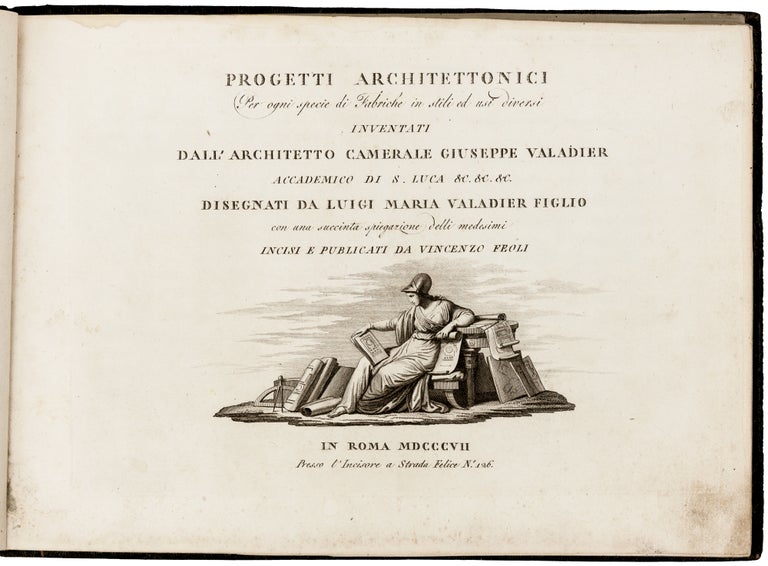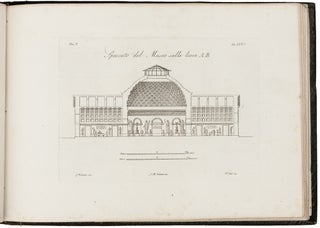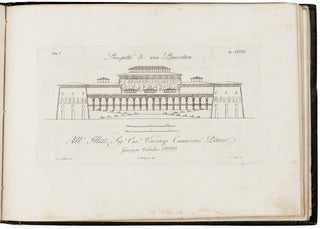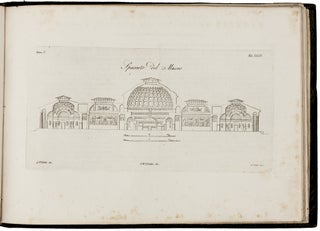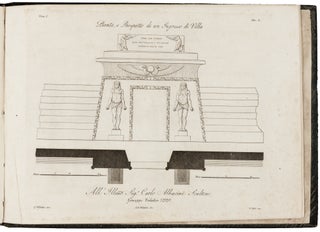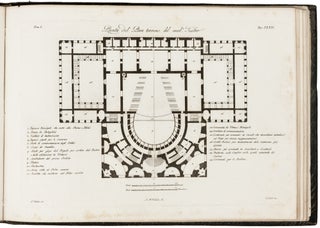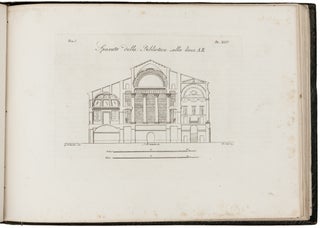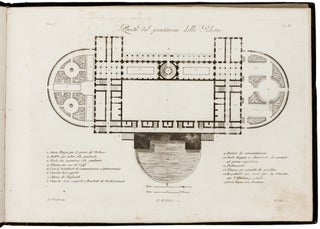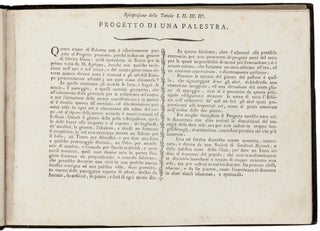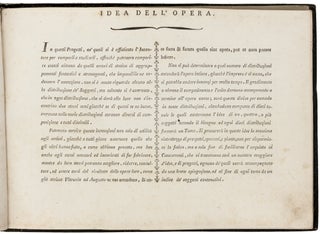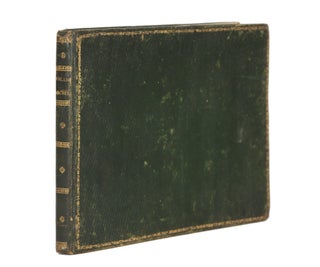Progetti architettonici per ogni specie di fabriche in stili ed usi diversi.
Oblong folio (216 x 310 mm). (18) leaves of text, including introduction and index (at the end), engraved title page, & 50 plates engraved by Vincenzo Feoli (1760?-1831) signed I-L. Bound in contemporary green morocco, borders and spine stamped in gold, covers and edges slightly worn. Occasional scattered foxing (mostly marginal), but overall a genuine and very good copy. A rare collection of sixteen architectural projects, complete as offered here and in their only early edition, each illustrated by several plates,by Giuseppe Valadier (1762-1839), the chief proponent of Neoclassicism in Italy. The proposals offer a comprehensive overview of Neoclassical civil and religious architecture. As Valadier writes in the introduction, he intended his book "not only for artists... but also for amateurs and those in charge of construction, so that they could choose, narrow down [the scope], consult, and be certain of the result of their work." Giuseppe Valadier was the son of Luigi Valadier (1726-1785), the most sought-after silversmith and decorative artist in late 18th-century Rome. Early on, Giuseppe developed a passion for architecture and quickly rose to prominence in the field. At the age of 24, he became the architect of the Papal States (architetto camerale) to Pope Paul VI. Among his numerous projects are the Villa Pianciani in Terraja (1784), the villa of Prince Stanisław Poniatowski (1757–1833) on the Via Flaminia in Rome, the façade of San Pantaleo in Rome (1806), and the clock on the right side of the front of St. Peter’s Basilica in the Vatican. His most well-known work is the massive urban reorganization of Piazza del Popolo in Rome into a multi-layered ensemble in the style of "eclectic picturesque Classicism," which modernized the traffic patterns, allowing easier access to the center of the city, as well as designing its elaborate stairs and terraces for the access to the “Pincio” gardens in Villa Borghese and the Casina Valadier, a jewel of a neoclassical villa in the Park. With the arrival of the Napoleonic troops in Italy, Valadier encountered new architectural competition, yet this did not preclude him from gaining prominence under the new regime: "Valadier’s broad education and equilibrated character made him employable on a wide range of tasks, and as such he was Napoleon’s key architect in Rome on the most important French projects" (Kirk, The architecture of Modern Italy, p. 115). Valadier's fascination with Neoclassicism must have helped him gain the attention of Napoleon, who saw Neoclassical architecture as a means of disseminating Republican ideals: "Republican ideals were projected onto the forms of established classicism... Classicism, or neoclassicism as he [Napoleon] would see it, contained simultaneously the rational underpinnings of a military engineer and the efficacious imagery of a propagandist" (Kirk, The architecture of Modern Italy, p. 87). Valadier's proposals in this book feature a gym (plates 1-4), a pavilion (plates 5-7), a commercial exchange (plated 8-10), a cemetery (plates 11-13), a countryside home (plates 14-17), a fortified city gate (plates 18-20), a public library (plates 21-24), a museum of sculpture (plates 25-27), a picture gallery (plates 28-30), a theater (plates 31-34), a cathedral (plates 35-37), an academy "of the nude" (plate 38-40), a museum of drawings (plates 41-43), a private theater (plates 44-46), Cabinet of Mars and Venus (plates 47-49), and an Egyptian Revival entrance gate for a villa or garden (plate 50). At least one proposal was implemented--the cemetery of San Lorenzo, completed in 1837. Each project is accompanied by a one-page description, explaining Valadier's design choices and ideas. For example, one reads in the text prefacing the library proposal that a library should be built in the center of town above the ground floor to ensure better conservation of volumes and quietude "for those, who have to and want to study." The projects bear dedications to important political figures, sculptors, architects, and artists, including the painter Angelica Kauffman (for the museum of drawings) and the sculptor Antonio Canova (for the museum of sculpture). The plates were executed by Vincenzo Feoli (1760?-1831)—a Roman engraver, who specialized in architectural subjects. His collaboration with Valadier began in 1794 with the publication of the first plans for the reorganization of Palazzo del Popolo and continued for twenty years. US copies: NYU, Avery, Dumbarton Oaks, and the Getty.
* References: Katalog der Ornamentstichsammlung der Staatlichen Kunstbibliothek, Berlin 2650; Kirk, The Architecture of Modern Italy: The Challenge of Tradition 1750-1900 (2005); "Valadier, Giuseppe" in Treccani; Debenedetti, Architetti e ingegneri a confronto: l'immagine di Roma fra Clemente XIII e Pio VII (2006), vol. 3, pp. 336 ff.
Sold

